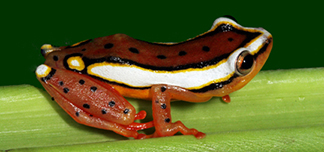Leptopelis parkeri Barbour and Loveridge, 1928
This species was named after Mr. H. W. Parker of the British Museum, who assisted Barbour and Loveridge by making comparisons with types in his care.
The IUCN Red List (2010) categorizes this species as Vulnerable because its Extent of Occurrence is probably less than 20,000 km2, its distribution is severely fragmented, and the quality and extent of its forest habitat in the Eastern Arc Mountains is declining (Howell et al., 2004).
It occurs in the Amani Nature Reserve, and in the University of Dar es Salaam's reserve at Mazumbai. It has not yet been recorded from Udzungwa National Park, but with further survey work probably will be shown to occur there.
It is affected by habitat loss as a result of expanding human settlements and agriculture, as well as the harvesting of wood. Its habitat in the East Usambara Mountains has recently come under serious threat as a result of the activities of illegal gold miners.
Populations of this species are decreasing (Howell et al., 2004).
This is a slender Leptopelis with bright red eyes. Males are typically dark gray or brown with an irregular pattern of yellow bars, while females are uniform olive- brown or gray. In both sexes the ventral surface is light in color and the toes and undersides of the limbs are yellow. The throat is white in males and orange in females. The tympanum is visible, but small and indistinct. Pupils are vertical. Toes are half webbed (Text from Harper et al., 2010).
According to Barbour and Loveridge (1928), this species is similar to L. uluguruensis, from which it is distinguished by its well separated vomerine teeth, its longer hind limbs, smooth dorsal skin and colouring. L. barbouri has similar eyes, but differs substantially from L. parkeri in dorsal coloration (Text from Harper et al., 2010).
Vomerine teeth are in two well-separated groups between the choanae. Head is broader than long. Distance between the nostrils is slightly shorter than the distance between a nostril and the anterior border of orbit, rather more than two-thirds the longitudinal diameter of the eye. Canthus rostralis is distinct; loreal region is concave. Tympanum is just distinguishable on both sides of head (possibly an individual character), measuring one-third the longitudinal diameter of eye opening. Inner finger is barely webbed, and the outer finger is one-third webbed. Digital disks are well developed. Toes are webbed to the disks on the inner side of the second, third, and fifth; only an indistinct seam to the disk of the fourth; first toe is half webbed. A small, thinly compressed, inner metatarsal tubercle (considerably different in appearance to that of L. uluguruensis) is present. The tibio-tarsal articulation of the adpressed hind limb reaches the nostril. Skin is smooth above and granular beneath except on tibia and sole of foot. Granulations of the throat are noticeable only on close inspection (Barbour and Loveridge, 1928).
Colour of holotype in alcohol: Dorsum is light yellowish-brown with very irregular stipples and dashes of dark rufous-brown on the back, besides several light spots. A line of stippling connects the upper eyelids. Loreal region to tympanum and along flanks is mottled with white and brown, as are the forelimbs with four crossbars on the forearm formed by a concentration of the mottling. The tibia also has four cross-bars indicated in a similar manner. The upper aspects of thighs and feet are mottled like the flanks. Venter is immaculate white, except for a little mottling on the extreme edges of the lower jaw (Barbour and Loveridge, 1928).
Males measure 34 – 43 mm in SVL, while females are approximately 56 mm (Harper et al., 2010). The holotype, a female, measures 45 mm (MCZ A-13597; Barbour and Loveridge, 1928).
Remains of grasshopper limbs and numerous leaf petals like those found in L. uluguruensis were found in the intestine; the stomach was empty except for two of these petals (Barbour and Loveridge, 1928). Other reported foot items include beetles, spiders, cockroaches and earwigs (Channing and Howell, 2006).
This species is endemic to mountains in the Eastern Arc chain of Tanzania, including Uluguru, Udzungwa, East and West Usambara, and South Pare Mountains. It most likely occurs more widely than these records suggest (Howell et al., 2004).
It inhabits closed, intact rainforest, not surviving in seriously disturbed habitats outside forest (Howell et al., 2004).
L. parkeri is found in montane forest from 200 – 2000 m. It does not tolerate severely modified habitat. (Harper et al., 2010).
This species can be rare in some localities and common in others (Howell et al., 2004).
It breeds in slow-flowing streams, although the eggs are laid in a nest on land not far from water (Howell et al., 2004). Eggs are laid in mud cavities near slowly flowing streams (Harper et al., 2010). Eggs as large as 4 mm have been found (Channing and Howell, 2006).
